Whether they be soaring at high altitudes or swooping down to the river in hopes of catching their next meal, it’s nearly impossible not to stop and admire these sizeable creatures. These raptors are instantly recognizable by their dark brown plumage, broad wings, hooked yellow beak and characteristic white or “bald” head (The Cornell Lab of Ornithology, 2015). Its no wonder the Bald Eagle is a renowned symbol of grace, power and pure magnificence.
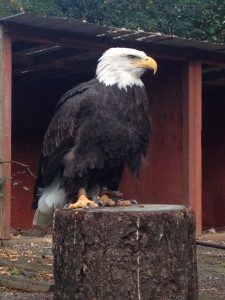
Manwe, a majestic male Bald Eagle at The Raptors (Photo by Chanelle Clement)
The Bald Eagle (Haliaeetus leucocephalus) is one of the largest birds of prey in North America with a typical wingspan between 6 to 7 feet and weighing in around 9.5 pounds (Sibley, 2016). Their weight however, depends on the sex of the bird, with females being slightly larger on average than males.
These talented birds of prey are known for their long, sharp talons as well as their exquisite eyesight, making them exceptional predators. It is estimated that an eagle’s vision is four to eight times better than that of a human, capable of seeing small objects that are over three kilometers away (Grambo, 1999)!

Luckily for these guys, their “baldness” refers to being white-headed rather than hairless! (Comic by Mike Bannon)
FUN FACT: The Bald Eagle is not actually bald! Their name is a misnomer which comes from the shortening of the term piebald. This term describes the contrast between the birds dark body and snowy white head (Reeb et al. 2007), creating the illusion of baldness from afar.
Although male and female Bald Eagles look identical, juveniles are almost completely covered in dark plumage, including their head and tail, and do not attain their adult plumage until they reach five years of age (The Cornell Lab of Ornithology, 2015). A surefire way to identify a juvenile Bald Eagle as it soars overhead is to search for distinctive white armpits.
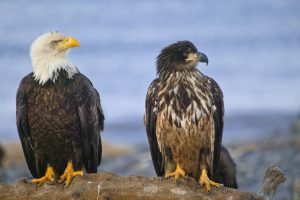
An adult Bald Eagle (left) vs. a juvenile Bald Eagle (right) perching on a log in Alaska (Photo by Rolf Hicker)
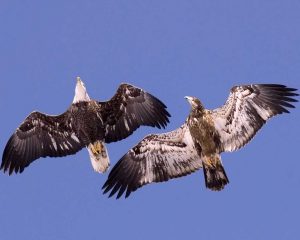
Bald Eagle (left) with almost complete adult plumage and a juvenile Bald Eagle (right) with characteristic white armpits (Photo by National Audubon Society)
One curious element to the strong and powerful Bald Eagle is their call. You may be surprised when you hear the not-so-impressive, high-pitched shrill emitted by this enormous bird.
Sound clip of Bald Eagle Call (Sound clip from VIU LEARN: BIOLOGY 325)
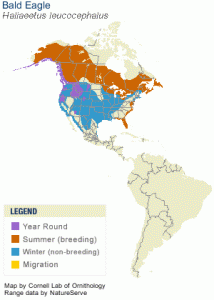
Bald Eagles are common across all of North America (Photo by The Cornell Lab of Ornithology)
The Bald Eagle is common across all of North America (Barry, 2015) as can be seen in the figure to the left. However, these raptors are most abundant in Alaska and Canada (National Geographic, 2017), especially along the coast of British Columbia. Most Bald Eagles spend their summers anywhere from Alaska to Newfoundland where they breed, while only some migrate south during the winter months in search of food and more favourable climates (Reeb et al. 2007).
Bald Eagles are often found anywhere near water including lakes, rivers, marshes and along coastlines (Cornell University, 2015). They are known to nest in forested areas close of water, and you can typically find them perching in tall mature tress, keeping an eye on any suspicious activity occurring down below (The Cornell Lab of Ornithology, 2015)!
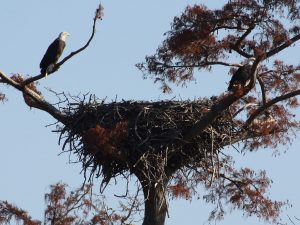
The largest recorded Bald Eagle nest can be found in St. Petersburg, Florida and weighs nearly 3 tons (National Eagle Centre, 2017)! (Photo by Edd S.)
Bald Eagles are also phenomenal builders! They are responsible for building the largest nest of any bird in North America (Journey North, 2017). Their nests typically span 5 to 6 feet in diameter and 2 to 4 feet tall, taking upwards of three months to build (The Cornell Lab of Ornithology, 2015)!
Both males and females work together in collecting the materials needed for the nest; however, it is the female who straps on her tool belt, in charge of nest construction and placement of branches, mosses and other plant stocks (The Cornell Lab of Ornithology, 2015). The nest is then lined with lichen and down feathers (The Cornell Lab of Ornithology, 2015), making it soft and suitable for young. When nesting sites in trees become scarce, Bald Eagles will build their nests on the ground or on cliff tops (Journey North, 2017).
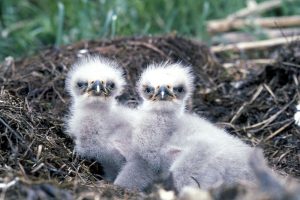
These adorable baby Bald Eagles are referred to as eaglets, relying completely on their parents for protection and care until they leave the nest (Photo by Peter Nye)
Bald Eagles are monogamous and mate for life, demonstrating site fidelity (returning to the same nest each year) after their first breeding season, occurring between the ages of four and five (National Audubon Society, 2017; Journey North, 2017). A female will lay 1 to 3 eggs per clutch, which hatch after approximately 35 days, with the eaglets remaining in the nest for 10 to 12 weeks after hatching (The Cornell Lab of Ornithology, 2015).
Bald Eagles can live anywhere from 20 to 30 years in the wild (Journey North, 2017) with the oldest recorded individual being 38 years of age when it died in 2015 (The Cornell Lab of Ornithology, 2015).
A feathered phenomenon! This incredible video highlights a recent and local adoption story of a Bald Eagle family raising a Red-tailed-Hawk chick as one of their own! Biologists believe the baby hawk was brought to the nest intended as a meal for the eaglets but instead started begging for food, causing the eagles parental instincts to kick in.
Check out the full news story here: http://www.cbc.ca/news/canada/british-columbia/bald-eagles-raise-red-tailed-hawk-1.4151033
Video of a Bald Eagle feeding its three eaglets (two on the left and one behind the adult) and a Red-tailed Hawk chick (Middle) in Sidney, BC this past june! (Video by David hancock)
Bald Eagles primarily feed on fish such as salmon, herring and catfish, but they can be quite adaptable including anything from birds, reptiles and small mammals such as rabbits into their meal plan (The Cornell Lab of Ornithology, 2015). Eagles have also been known to engage in kleptoparasitism (stealing the food of other animals) as a form of scavenging (Dekker and Drever, 2015). Sadly, many Bald Eagles have been known to forage in garbage dumps in attempt to supplement their diet when food sources become scarce or when lacking hunting experience (Elliott et al. 2006; Turrin et al. 2015). For more information on the foraging behaviour of Bald Eagles and the impact of landfills as a food source, check out my second blog post!
These glorious birds are also known for their powerful flight tactics. They are capable of soaring large distances and plunging to great depths to catch fish right out of the water using their long sharp talons! Check out the video below to see this in action!
Video of a bald eagle catching a fish (video from BBC one)
And regrettably, sometimes they end up taking a swim!
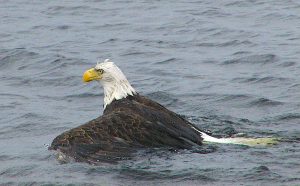
A soggy Bald Eagle swimming to shore after taking an unexpected dip into the lake! (Photo by Nation Park Service)
Fortunately for these brilliant birds, they are listed as least concern by the IUCN and their populations are increasing (BirdLife International, 2016). However, this was not the case in the 1900’s. Over the past two centuries, the Bald Eagle has faced dramatic population declines due to the wide use of pesticides such as DDT which decreased eggshell thickness (Sorenson et al. 2017), significantly reducing their reproductive success. Populations also declined due to lead poisoning, shooting and habitat destruction (The Cornell Lab of Ornithology, 2015). However, things started looking up for the Bald Eagles in 1978. Being listed under the Endangered Species Act (The Cornell Lab of Ornithology, 2015; Sorenson et al. 2017) and the co-current ban of DDT has lead to an incredible resurgence of these raptors. With a current global breeding population estimated at 250,000 individuals (The Cornell Lab of Ornithology, 2015), it goes to show that the Bald Eagles were a part of a true conservation success story!
References:
Barry, K.L. 2015. Bald Eagle. Atlas of the Breeding Birds of British Columbia. [Internet]. Retrieved November 12, 2017 from http://www.birdatlas.bc.ca/accounts/speciesaccount.jsp?lang=en&sp=BAEA
BirdLife International. 2016. Haliaeetus leucocephalus. The IUCN Red List of Threatened Species 2016. Retrieved November 12, 2017 from http://www.iucnredlist.org/details/22695144/0
Dekker, D. and M.C. Drever. 2015. Kleptoparasitism by Bald Eagles (Haliaeetus leuconcephalus) as a Factor in Reducing Peregrine Falcon (Falco peregrinus) Predation on Dunlin (Calidris alpine) Wintering in British Columbia. The Canadian Field-Naturalist 129: 159-164. Retrieved November 12, 2017 from https://www.sfu.ca/biology/wildberg/NewCWEPage/papers/DekkerDreverCFN2015.pdf
Elliott, K.H., Duffe, J., Lee, S.L., Mineau, P. and J.E. Elliott. 2006. Foraging Ecology of Bald Eagles at an Urban Landfill. The Wilson Journal of Ornithology 18(3): 380-390. Retrieved November 12, 2017 from http://www.bioone.org.ezproxy.viu.ca/doi/pdf/10.1676/04-126
Grambo, R.L. 2003. Eagles. Voyageur Press, Inc. [Internet]. Retrieved November 12, 2017 from https://books.google.ca/books?id=O5J8JK07QykC&pg=PA11&redir_esc=y#v=onepage&q&f=false
Journey North. 2017. Bald Eagle Nest Building. [Interent]. Retreived November 12, 2017 from https://www.learner.org/jnorth/tm/eagle/annual/jan_nest.html
National Audubon Society. 2017. Bald Eagle (Haliaeetus leucocephalus). [Internet]. Retrieved November 13, 2017 from http://www.audubon.org/field-guide/bird/bald-eagle
National Eagle Center. 2017. Bald Eagle Nesting and Young. [Internet]. Retrieved November 14, 2017 from https://www.nationaleaglecenter.org/eagle-nesting-young/
National Geographic. 2017. Bald Eagle. [Internet]. Retrieved November 12, 2017 from https://www.nationalgeographic.com/animals/birds/b/bald-eagle/
Reeb, M.L., Wiland, L., Yao, T. 2007. Migratory Birds of the Great Lakes. University of Wisconsin Sea Grant. [Internet]. Retrieved November 12, 2017 from http://seagrant.wisc.edu/birds/bald_eagle_intro.html
Sibley, D. A. (2016) Sibley Birds West: Field Guide to Birds of Western North America: Second Edition. Knopf Doubleday Publishing, New York, New York. p. 111.
Sorenson, K.J., Burnett, L.J. and M.M. Stake. 2017. Restoring a Bald Eagle Breeding Population in Central California and Monitoring 25 Years of Regional Population Growth. Journal of Raptor Research 52(2): 145-152. Retrieved November 12, 2017 from http://www.bioone.org.ezproxy.viu.ca/doi/pdf/10.3356/JRR-16-35.1
The Cornell Lab of Ornithology. 2015. All About Birds: Bald Eagle. [Internet]. Retrieved November 10, 2017 from https://www.allaboutbirds.org/guide/bald_eagle/id
Turrin, C., Watts, B.D. and E. K. Mojica. 2015. Landfill Use by Bald Eagles in the Chesapeake Bay Region. Journal of Raptor Research 49(3): 239-249. Retrieved November 12, 2017 from http://www.bioone.org.ezproxy.viu.ca/doi/pdf/10.3356/JRR-14-50.1
Great post! I think I have heard of other species getting stuck in the water and dying from becoming tired and drowning. Have you heard of this happening to any Bald Eagles?
Hi Caitlynn! Thank you for your comment and feedback! There have been a few recorded Bald Eagle mortalities due to drowning, however their numbers are minimal in comparison to other causes of death, such as collisions, shootings and poisonings. One study I found summarized the causes of deaths for Bald Eagles between 1982 and 2013 based on carcass submissions and concluded that only 0.4 % of Bald Eagles died due to drowning (Russell and Franson et al. 2014). There is the common misconception that eagle talons feature an involuntary locking mechanism upon grasping their prey, which is not the case. Drowning of Bald Eagles typically results from them refusing to let go of large prey items alongside hypothermia due to extended periods of time spent in the water. Eagles are strong swimmers, and therefore make it back to shore the majority of the time! Quite often, humans have been known to lend them a hand, making for some heartwarming rescue stories such as the ones I’ve included below!
https://news.nationalgeographic.com/2017/08/bald-eagle-swimming-rescued-video-spd/
http://www.huffingtonpost.ca/entry/fisherman-rescues-drowning-eagle-canada_n_5952708
Great blog post Chanelle. I especially enjoyed the pictures and videos you included as well as the comic, it was a great way to explain why they are called “bald” eagles. I didn’t know that’s where the name came from prior to reading your blog. You mentioned that the Bald Eagle builds one of the largest nests of all birds in North America, but they are not the largest bird in North America. Did you come across any reasoning as to why they invest so much time and energy into building such elaborate nests? Maybe it’s so they can adopt other birds like the Red-tailed Hawk?
Thank you for your comment Nicole! I believe there are a number of reasons for their large nest size other than housing baby Red-tailed Hawks! Both males and females contribute to raising of their young, which makes for a large family of eagles, ranging in size from 3 to 5 birds! Because eaglets remain in the nest for up to 12 weeks after hatching, the nest must be “roomy” enough to fit both adults as well as the growing eaglets. Bald Eagles are also very territorial birds, another factor that contributes to their large nests. As was mentioned in my blog, Bald Eagles often use their nests for several decades, returning to the same location year after year. For these reasons, it poses very beneficial for Bald Eagles to seek out the strongest trees which are located near an abundance of resources and to build, a large, comfortable and sturdy home!
Great-blog post Chanelle! I really enjoyed the fun fact about how they got the name “bald” eagle. Do you know why they have a white head, is there an evolutionary advantage to his?
Thank you! I was also curious about this while writing my blog! I was unable to find a source that explained the exact importance or evolutionary advantage to having a white head but I do remember Gerard talking about it on our trip to The Raptors Centre. I believe he mentioned that their white head helps to break up the Bald Eagle’s large, dark body in attempt to make them appear smaller than they actually are. This is most likely the reason they also have a white tail! Perhaps this helps them in hunting for their prey. It is interesting to think that these birds have evolved a white head when other similarly large sized birds such as the Golden Eagle have not! I will definitely keep an eye on the literature for any information on this topic! Great question 🙂
Nice blog Chanelle! I really enjoyed the video about the eagles adopting a red-tail hawk; it’s quite a remarkable phenomenon for sure. Have you come across other abnormal behaviours exhibited by eagles, with regards to interacting with different animal species?
Hi Marina! Thank you for your feedback! I was also fascinated with the adoption of the Red-tailed Hawk, it’s my favourite part of the blog! If you’re interested, I have found a short video update on the hawk, since named “Spunky”, who has continued to live with his Bald Eagle family and has even begun to exhibit eagle-like behaviours! Heres the link: https://www.youtube.com/watch?v=AUM99UXMbow. I haven’t come across any other abnormal behaviours exhibited by Bald Eagles, however, I did find a few interesting videos! A women in Alaska has posted several videos of her cat sitting on their porch right next to one of the many Bald Eagles who frequent the area! I find it amazing that the Bald Eagles just perch on the railing right next to the cat without attacking it. Here’s one of her videos: https://www.youtube.com/watch?v=M9EBofaI5Xs. These birds of prey are definitely full of surprises!
Thanks Chanelle! I especially loved the cat and eagle video. The eagle is so huge compared to the cat and didn’t seem bothered at all being that close together! The other videos from the same Youtuber are pretty interesting as well 😉
Very nice blog and well detailed. Love the videos you incorporated. One wonders if the RTHA will be confused because it was raised on a fish diet. It’s not really equipped to catch fish. Looks like the eagle wants to take a good poke at the cat!
Thank you Eric! The video I included in reply to Marina’s comment suggests that the RTHA has been eating fish stolen from other birds but has also been seen to swoop down in the forest and fields to practice catching other forms of prey (Video: https://www.youtube.com/watch?v=AUM99UXMbow). I am definitely looking forward to keeping up to date with this story!
It’s too bad the bird wasn’t banded. Unless it stays in the area, there’s likely know way of distinguishing it from others.